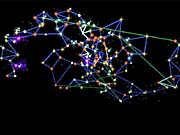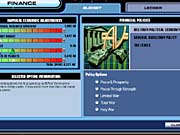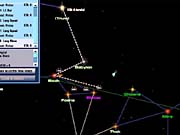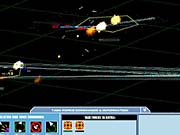Quicksilver's Master of Orion III is more complex than any of the previous games in the turn-based strategy series of interstellar conquest, and yet it lacks much of what made its predecessors such classics. The design relies on extensive automation to make it playable, and at its best, Master of Orion III succeeds in reducing the micromanagement that often plagues the later stages of games in this genre. But the combination of weak opponent AI, unappealing graphics, and having to second-guess the automation makes for an experience that is much less rewarding than you might hope, especially considering how much effort you must exert to get used to the game's complicated interface.

Many of the basic mechanics in Master of Orion III are the same as in the previous games. You start out in a lone system that's being orbited by a couple of scout ships and a colony ship. You start exploring and colonizing your corner of the galaxy and balance the need to build new colony ships against developing infrastructure so that you can build ships faster later on. Colonies take a long time to develop, depending on how suitable the worlds are for your species, and are pretty much defenseless early on. It won't be long before you bump into other species, though it may take a while to set up diplomatic relations, and you have to build military ships just to guard your fledgling territories and set up choke points to prevent other empires from sending colony ships to parts of space you'd rather consider your own. Early decisions determine the course of your empire, but there's really not a lot of action at this point in a game.
It can take a long time to make any progress in your first game of Master of Orion III. Not only does it take some effort to get used to the game's sprawling interface, but basic things like moving a ship to a location a few systems away or building a new colony ship can take a dozen turns, at least at first. And unlike other turn-based strategy games, Master of Orion III doesn't prompt you to advance turns when all your units have movement orders. The game's pace picks up only once you've started hitting the "next turn" button every few minutes, though you can at least research technologies that get your ships moving faster.
Master of Orion III may seem like a daunting game, but it's not a difficult one. Unfortunately, new players don't even get the luxury of a real tutorial to help them along. When you first boot up the game, you can choose the "quick game" option from the main menu to bypass the options for setting up a game and be dropped immediately into a large galaxy map. The closest thing to a tutorial is the "master's notes," a series of text boxes that appear on every new interface screen. The master's notes are long and dull to read, but they're still more useful than the game's manual, which was apparently printed long before the game was released and is rather outdated; in fact, the game's readme documentation file has a long list of manual errata. The manual's true purpose seems to simply be to relate the game's background story, which may satisfy a few extremely curious players but doesn't otherwise play much of a role in the game.
If you've ever wondered how big a galaxy really is, Master of Orion III's main 3D map should give you some idea. The game succeeds in conveying the truly massive scale of space, since playing a small, simple map just isn't an option. You can play a small cluster galaxy, but even this kind of map will be a ball-like cluster of 50 to 100 stars--a map you'll have to rotate about just to get a sense of how far each star is from its neighbor and how far your own civilization's borders extend. The standard spiral galaxy maps are actually simpler to play, since you can usually leave the universe locked in the overhead view.

This sense of scale carries over to many other parts of the game and contributes to the mazelike interface. There are eight major reference screens for elements like finance, diplomacy, and shipbuilding, and each one has at least two major window views. The important planetary management screen contains no fewer than six submenus to control the finance and infrastructure for one of many planets in your empire and to passively consult the demographics, local military status, and environment suitability. And there are separate expandable screens for the two build queues. While this setup does hide unnecessary details, it also forces you to open up even more screens before you can get to the production controls you need to get to most. Master of Orion III features AI automation that will carry out basic tasks for you, and this automation generally handles finance and basic infrastructure building fairly well, but it's pretty terrible at choosing military projects to build. As such, it's too bad the build queues aren't surfaced more prominently at the planet level and on the overview screen that lists all the planets in your empire. Still, there are ways to limit how often you need to tweak production, first by marking ship designs obsolete and then by adding orders to build five or 10 of something to the otherwise short three-slot queue.
The game's automation is arguably helpful and does keep Master of Orion III moving even when you're running an empire of 50 or more colonies--in these cases, letting less-than-competent AI automation take care of the details seems like a much more attractive prospect than micromanaging every last colony. However, the game's opponent AI is simply bad. In fact, it's actually difficult to lose a single-player game because of how rarely a computer-controlled empire will attack even completely undefended planets. The higher difficulty settings don't make the AI any more warlike, but they do make the other empires expand more effectively and defend their planets better. So instead of being a game about conquering the galaxy by fighting battles here and there, the real challenge in Master of Orion III is gobbling up new worlds faster than other empires and then grinding through the weak to moderate defenses of every other world on the map. There's not much reason for you to build your own defenses, such as orbital defenses or system ships--although planetary shields keep piracy and unrest down. The only defenses you really need to build are just to keep your opponents' pesky colony ships from getting to their destinations.
It's true that setting a game of Master of Orion III at different difficulty levels really doesn't make any difference when starting a new game, but the game does have a few other settings that do matter. While conquering every single planet always assures you the satisfaction of an overwhelming victory, it's possible to turn off the other two victory conditions. The easiest goal to win, or lose, is the presidency of the Orion Senate. If your empire is randomly picked to start out in the galactic core and belongs to the senate, then you have a leg up, since you'll at least be aware of the periodic presidential elections and the generally insignificant legislation that comes up for members to vote on. The new orions, as the elder race, are seemingly satisfied with their single planet and superior technology and only occasionally send out their massive fleets or flaunt their massive 1000-senate-vote edge. But after around 200 turns, an expansionist empire will have enough votes to challenge the orions for the podium. If you care to, you can simply end your game early at this point, but if not, your game may be ended for you--and completely without warning if you don't belong to the senate.

The other victory condition requires you to find five ancient artifacts, which lend major empire bonuses when you finally find one and wait for the necessary research to be complete. The process is so long, involved, and secondary to the main action of the game that it's not a compelling alternative goal. No matter what strategy you decide to focus on (military, economic, or otherwise), it's hard to track your progress compared to other empires because the only relative rank is a numerical power rank that conflates a variety of factors. Don't look for detailed graphs listing all the empires' relative success in research, population growth, military strength, or the like. That sort of detailed data is available only on the victory screen.
Selecting and customizing your race is an even more important consideration while setting up a new game. Master of Orion III has 16 default races, but there are few limits to the customization, so you can simply pick a portrait you like and choose attributes you think will give you the most advantage. Some racial bonuses are much more beneficial than others, and some races are much harder to play than others, but the game gives no indication to new players about what makes one race better than another.
Master of Orion III packs in every gameplay component you might expect from playing early games in the series, and although most are incredibly more detailed, they lose some personality in the process. There's a certain appeal to researching exotic-sounding technologies, but the game has so many of them that it's hard to get a sense of what does what. But don't worry about keeping track, because you can more or less forget about that part of the game while the automation just keeps things plodding along. That's not to say that research doesn't matter, because new technology does unlock new ship sizes and weapons, infrastructure upgrades, and general empire bonuses. However, if you wanted to focus on designing a fleet of powerful starships, you'll find that you really only need to track which enhancements you're adding to your designs. Otherwise, you'll basically just press the auto-build button. Individual ships can't move by themselves and must be assigned to task forces, and to differentiate otherwise generic ships, there are a few different mission types that each ship design and task force must specialize in, such as long-range attacks, missiles, fighter carrier, point defense, and planet destroying. Master of Orion III at least has a simple rock-paper-scissors balance scheme for its ship types, meaning you can't simply build a single, all-purpose design.
Master of Orion III does feature a pretty pronounced emphasis on waging war, but unfortunately, the actual combat isn't very interesting. It's possible to automatically resolve most combats, but you can at least make a small difference if you decide to command tactical combat in larger battles. You don't have much control over ships and can't directly tell what ships are equipped with what weapons, but at least you find out more than just whether you won or lost a battle, and you'll find at least a little satisfaction in a large-scale battle between huge invading armadas and a heavily defended planet.

The best thing you can say about Master of Orion III's visuals is that they come with some of the lowest system requirements of any PC game this year. The 2D menus consist of very plain-looking blue blocks. The planetary system view and the galactic map don't look bad and are certainly throwbacks to earlier games in the series, but the overall 2D presentation simply doesn't match up to what you might expect from a 2003 game. Unfortunately, Master of Orion III's tactical combat looks especially bad, because the realistically large scale of the map makes the ships look incredibly small on the screen--little more than dots that shoot variously colored jaggy lines. But since you spend most of your time on the galactic map and planet management screens, the fact that the menus open and close quickly, and that you can switch to a new turn quickly, at least keeps your attention focused on the game at hand. Also, Master of Orion III's musical score is very appropriate for its subject matter and makes a good accompaniment while running through a few hundred turns in an afternoon.
Master of Orion III is a disappointing follow-up to the two most significant space empire games ever. The core gameplay is enjoyable enough if you actually spend enough time getting used to the complex interface, but the timid opponent AI keeps the game from being really interesting. Master of Orion III underwent a significant design change early this year to increase the player's direct involvement in the game. Unfortunately, this change doesn't seem to have turned out the way it was intended to; the game's automation helps in many cases, but otherwise, it simply hides whatever decisions it makes from plain sight, and it does a terrible job of managing production. Given its complexity, Master of Orion III can offer plenty of deep gameplay to devoted players, but its AI flaws keep it from giving a satisfying payout in exchange for all that effort.